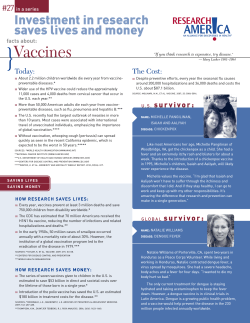
- Emory Mom Vax
Communication Guidance and Talking Points for OB/GYN Providers: Encouraging Patients to Receive Flu and Tdap Shots during Pregnancy Communication Strategies: How to Have a Successful Dialogue (From: http://mail.ny.acog.org/website/immunizationresourceguide.pdf) A successful discussion about vaccines involves a two-way conversation, with both parties sharing information and asking questions. These communication principles can help you connect with your patients by encouraging open, honest and productive dialogue. Take Time to Listen Despite a full schedule, resist the urge to multi-task, and give patients your full attention. Restate your patient’s concerns to be sure you understand her viewpoint. Your willingness to listen will play a large role in helping her with her decision to get vaccinated. Don’t be Offended Some patients may come to you with a list of questions or information from a variety of sources. Do not interpret this as a lack of respect for you or a lack of intelligence on the part of your patient. If you appear offended by her questions, dialogue may shut down and trust may be eroded. Science vs. Anecdote Too much science may frustrate some patients, while too little may frustrate others. For some patients, a story from your experience about an unprotected patient who became ill may be on target. Which approach to use will depend on your knowledge of your patients, so be prepared to use a mix of science and personal stories that will be most effective in addressing patients’ questions. Acknowledge Benefits & Risks It is important to emphasize the benefits of vaccination and also explain that vaccines may vary in their efficacy. It is honest and important to say that not vaccinating is a risk. Never state that vaccines are risk-free. Always discuss the known side effects caused by vaccines. It is important to utilize the Vaccine Information Statements (VISs) to support your discussion. Refusal The choice for immunization rests with your patient (or her guardian). Visit www.immunizationforwomen.org for more information on providing patient education for those patients who refuse immunizations. After the Office Visit If a patient expresses extreme concern during her office visit, contact her a few days later. A caring call or e-mail will provide her with comfort and reassurance. Educating your patients by providing them with the information to make informed decisions is essential to encourage them to receive recommended vaccinations. Nurses and other office staff can play a significant role in establishing and maintaining a practice-wide commitment to communicating about vaccines and maintaining high vaccination rates. This can be achieved by: providing patients with educational material; being available to answer questions and making sure that those patients who schedule extra visits for vaccines, make and keep vaccine appointments. Doctor-to-Patient Talking Points: TDAP VACCINATION DURING PREGNANCY All women should receive the tetanus toxoid, reduced diphtheria toxoid and acellular pertussis (Tdap) vaccine; this is particularly important for pregnant women because they are susceptible to acquiring pertussis (whooping cough), and newborns are at highest risk of having severe complications from pertussis. Primary Tdap vaccine doctor-to-patient talking points: 1. I strongly recommend that you receive a Tdap vaccine during pregnancy. The Tdap vaccine protects you and your baby from tetanus, diphtheria, and pertussis, which is whooping cough. Newborns are the highest risk group for complications from whooping cough, so getting a Tdap shot during pregnancy is the best way to protect both you and your baby. 2. Whooping cough cases, which have been increasing in the U.S., are worst for infants because their tiny airways get clogged from mucous and they cannot breathe. Getting your Tdap shot during pregnancy gives your baby a headstart on protection. The antibodies you create to the shot pass to your baby before birth and can protect him/her in their most vulnerable first months. 3. The Tdap vaccine is safe to receive at any point during pregnancy, but I recommend getting it in your second or third trimester so that your baby receives the most antibodies against whooping cough right before birth. More safety-related talking points: The recommendation for pregnant women to receive the Tdap shot during pregnancy as opposed to immediately post-partum started in 2011. This change in the CDC recommendation was made after review of safety data from several sources including adverse event registries, pregnancy registries from vaccine manufacturers, and other research studies. Unvaccinated adolescents and adults, including adults aged 65 years and older, who will have contact with infants younger than 12 months of age should also receive a single dose of Tdap. Remember: the most effective way to increase your patient’s vaccination acceptance rate is for you to directly recommend and provide the vaccine. Talk to your patients about the Tdap shot today. Reference: ACOG Tdap vaccination script for providers: http://www.immunizationforwomen.org/site/assets/docs/Phys%20Script%20TDAP%281%29.pdf
© Copyright 2025









